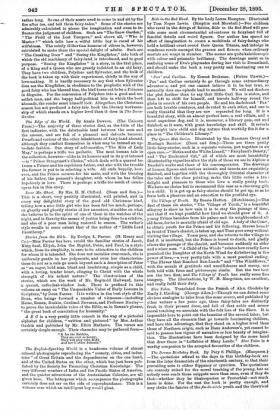The Village of Youth. By Bessie Hutton. (Hutchinson.)—The first of
these six stories, "The Village of Youth," is a beautiful allegory to show us how vain it is to stay the passage of time, and that if we kept youthful how tired we should grow of it. A young Prince banishes from his palace and its neighbourhood alt old faces, for he is mortally afraid of old age. A lady of the Court-, to obtain youth for the Prince and his following, throws herself in front of Time's chariot, is taken up, and Time goes away without visiting the village. Years pass, and she returns to the village to. find it is unaltered, but the Prince is bored to death, and gladly allows the passage of the chariot, and becomes suddenly an older and a wiser man. "A Child of the Winds "relates how cruelly Love punished the Daughter of the North Wind for diebelieving in the power of love,—a very pretty tale with a most poetical ending. "The Flower that Reached Sun-Lands" and "The Windflower," with the morals of gratitude and unselfishness and mercy, are both told with force and picturesque simile. But the two best are the two first, and The Village of Youth has really some fine imagery. The illustrations, by W. H. Margetson, are excellent, and really fulfil their duty.


































 Previous page
Previous page